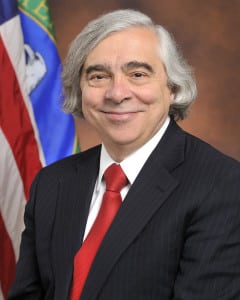
At some point in the future, an economy-wide legislative approach will be necessary to reach the United States’ long-term climate goals, Energy Secretary Ernest Moniz said Wednesday at the Going Green Conference hosted by the European Commission in Washington, D.C. “I think personally, eventually some administration will have to be working with Congress to find a more comprehensive legislative solution,” Moniz said.
The Obama administration tried to do so when it laid out the president’s Climate Action Plan, according to Moniz, but there has been no significant movement forward with Congress. The Climate Action Plan, released in 2013 sets goals to reduce carbon pollution, prepare the nation for the impacts of climate and to take a leadership role in global efforts to combat climate change.
However, the energy boss stressed, plenty of advancements can be made without relying on Congress. In fact, Moniz said, these actions will be enough to realize the nation’s short-term climate goal under the Paris Agreement of reducing carbon emissions 26-28 percent below 2005 levels by 2025. However, Congress will need to be pulled in to achieve the 2050 goal of a 50-percent reduction of these emissions.
“In the United States, I believe that the president’s Climate Action Plan is very strong and can certainly, with existing technologies and foreseeable evolutionary improvements, can get us to our 2020 goal and our 2025 goal, which is our Paris goal,” Moniz said.
Moniz said the nation’s involvement in the Mission Innovation initiative, a group of 20 countries that have pledged to double their respective clean energy research and development funding, will play a significant role in pushing past the 2025 goal. However, he added, technological innovation will not be enough: “We will also need policy innovation.”
It is important to look at the energy sector as a whole, according to Moniz, where innovation in one area can lead to advances in another. The energy market, energy policy, and energy technology are intrinsically linked. “The bread and butter of the energy sector is providing, let’s face it, what is a commodity: electricity, mobility, heat, in increasingly inexpensive ways and that will be the product of innovation. The lower cost, the continued drive to lower costs will enable much easier policy-making, which could be a carbon tax, a carbon charge,” he explained.
Moniz also stressed a need to be inclusive when exploring clean energy technology solutions. “There is no one zero or low-carbon solution. There are going to be multiple solutions that look very different in different countries, and they’re going to look very different within regions of our country,” he said.
Carbon capture and storage technology is one of the less discussed technologies of the clean energy movement, but will be vitally important to reaching global climate goals. It is important to note, Moniz said, that CCS’s potential expands far beyond coal-fired power plants. “We usually focus on CCS for power plants, coal plants, and eventually natural gas plants, but we should also remember that it may be the only option in many cases for major industrial plants and sources,” he said.
Furthermore, he said, the opportunities available in carbon utilization are far vaster than current applications. “Today the utilization of captured carbon dioxide is almost exclusively for enhanced oil recovery, but something that does not violate the laws of physics we are doing it, … is the conversion of sunlight plus CO2 and water into a drop-in liquid fuel, that’s being worked on, it can be done,” he said.